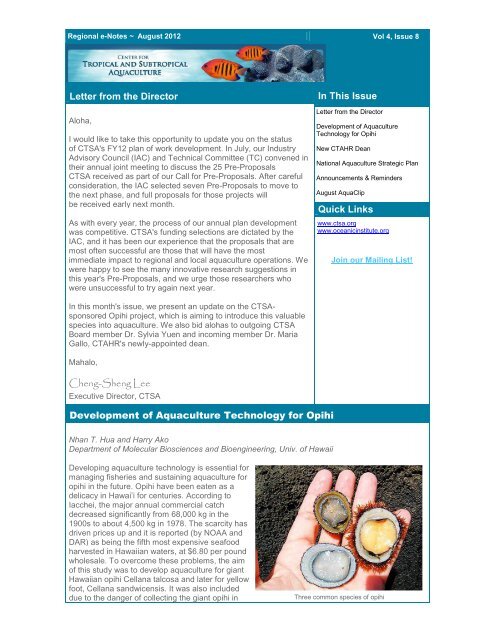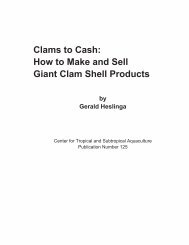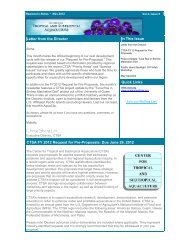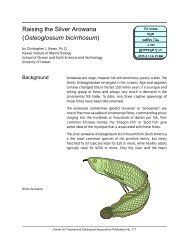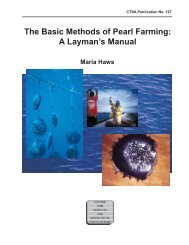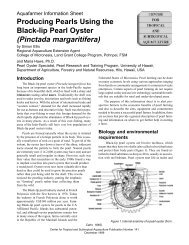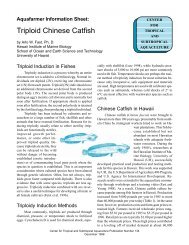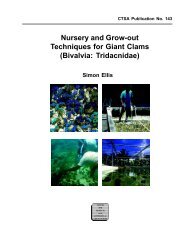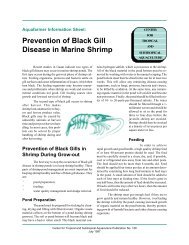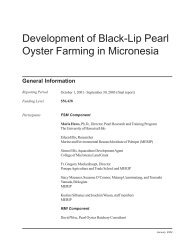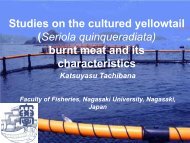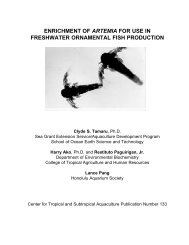Letter from the Director Cheng-Sheng Lee In This Issue ... - CTSA
Letter from the Director Cheng-Sheng Lee In This Issue ... - CTSA
Letter from the Director Cheng-Sheng Lee In This Issue ... - CTSA
You also want an ePaper? Increase the reach of your titles
YUMPU automatically turns print PDFs into web optimized ePapers that Google loves.
Regional e-Notes ~ August 2012 Vol 4, <strong>Issue</strong> 8<br />
<strong>Letter</strong> <strong>from</strong> <strong>the</strong> <strong>Director</strong><br />
Aloha,<br />
I would like to take this opportunity to update you on <strong>the</strong> status<br />
of <strong>CTSA</strong>'s FY12 plan of work development. <strong>In</strong> July, our <strong>In</strong>dustry<br />
Advisory Council (IAC) and Technical Committee (TC) convened in<br />
<strong>the</strong>ir annual joint meeting to discuss <strong>the</strong> 25 Pre-Proposals<br />
<strong>CTSA</strong> received as part of our Call for Pre-Proposals. After careful<br />
consideration, <strong>the</strong> IAC selected seven Pre-Proposals to move to<br />
<strong>the</strong> next phase, and full proposals for those projects will<br />
be received early next month.<br />
As with every year, <strong>the</strong> process of our annual plan development<br />
was competitive. <strong>CTSA</strong>'s funding selections are dictated by <strong>the</strong><br />
IAC, and it has been our experience that <strong>the</strong> proposals that are<br />
most often successful are those that will have <strong>the</strong> most<br />
immediate impact to regional and local aquaculture operations. We<br />
were happy to see <strong>the</strong> many innovative research suggestions in<br />
this year's Pre-Proposals, and we urge those researchers who<br />
were unsuccessful to try again next year.<br />
<strong>In</strong> this month's issue, we present an update on <strong>the</strong> <strong>CTSA</strong>sponsored<br />
Opihi project, which is aiming to introduce this valuable<br />
species into aquaculture. We also bid alohas to outgoing <strong>CTSA</strong><br />
Board member Dr. Sylvia Yuen and incoming member Dr. Maria<br />
Gallo, CTAHR's newly-appointed dean.<br />
Mahalo,<br />
<strong>Cheng</strong>-<strong>Sheng</strong> <strong>Lee</strong><br />
Executive <strong>Director</strong>, <strong>CTSA</strong><br />
Development of Aquaculture Technology for Opihi<br />
Nhan T. Hua and Harry Ako<br />
Department of Molecular Biosciences and Bioengineering, Univ. of Hawaii<br />
Developing aquaculture technology is essential for<br />
managing fisheries and sustaining aquaculture for<br />
opihi in <strong>the</strong> future. Opihi have been eaten as a<br />
delicacy in Hawaiʽi for centuries. According to<br />
Iacchei, <strong>the</strong> major annual commercial catch<br />
decreased significantly <strong>from</strong> 68,000 kg in <strong>the</strong><br />
1900s to about 4,500 kg in 1978. The scarcity has<br />
driven prices up and it is reported (by NOAA and<br />
DAR) as being <strong>the</strong> fifth most expensive seafood<br />
harvested in Hawaiian waters, at $6.80 per pound<br />
wholesale. To overcome <strong>the</strong>se problems, <strong>the</strong> aim<br />
of this study was to develop aquaculture for giant<br />
Hawaiian opihi Cellana talcosa and later for yellow<br />
foot, Cellana sandwicensis. It was also included<br />
due to <strong>the</strong> danger of collecting <strong>the</strong> giant opihi in<br />
<strong>In</strong> <strong>This</strong> <strong>Issue</strong><br />
<strong>Letter</strong> <strong>from</strong> <strong>the</strong> <strong>Director</strong><br />
Development of Aquaculture<br />
Technology for Opihi<br />
New CTAHR Dean<br />
National Aquaculture Strategic Plan<br />
Announcements & Reminders<br />
August AquaClip<br />
Quick Links<br />
www.ctsa.org<br />
www.oceanicinstitute.org<br />
Join our Mailing List!<br />
Three common species of opihi
deep water where <strong>the</strong>y exist, as many people have been swept away and drown while collecting<br />
opihi. For this reason, opihi have been called <strong>the</strong> "fish of death".<br />
<strong>In</strong> our first year of study we have turned opihi aquaculture <strong>from</strong> an unknown to a standard<br />
aquaculture research object. We began our study with collection of animals <strong>from</strong> <strong>the</strong> wild. We first<br />
encountered high mortality (58%) within few days (3-4 days) after collecting. We presumed <strong>the</strong><br />
mortalities occurred due to injury while prying opihi off <strong>the</strong> rocks. We tried to detach <strong>the</strong>m quickly<br />
before <strong>the</strong>y became alarmed and would cling more tightly into <strong>the</strong> rocks. We obtained 82%<br />
survivors by <strong>the</strong> fourth collection.<br />
An additional high mortality of 53% occurred while transferring animals <strong>from</strong> one holding tank to<br />
ano<strong>the</strong>r because <strong>the</strong> animals attached tightly to <strong>the</strong> wall of <strong>the</strong> tank and were hard to get off. We<br />
auditioned several tank liners. The one we settled on was sold as a dropcloth for painting (Fig 1).<br />
Later soft plastic colanders were used (Fig. 2). Both tanks overlaid with plastic liner or colanders<br />
reduced this mortality to zero in subsequent experiments because animals could be easily removed<br />
<strong>from</strong> <strong>the</strong> wall of <strong>the</strong> tank by gently deforming <strong>the</strong> plastic. They would fall off and could be picked up<br />
by hand.<br />
We <strong>the</strong>n focused on trying to deduce <strong>the</strong> preferred feed of opihi by investigated <strong>the</strong> natural food by<br />
stomach content analysis. Stomach contents contained benthic diatoms (about 30% of <strong>the</strong> materials<br />
seen), bacterial clumps and o<strong>the</strong>r un-identifiable particles. Twenty diatom species were seen and<br />
<strong>the</strong> most frequently seen were Bacillaria sp, Fragilaria sp, Melosira sp, Navicula, sp and<br />
Rabdonema sp. We subsequently were able to culture <strong>the</strong>se algae and would hold <strong>the</strong> animals for a<br />
while feeding on <strong>the</strong> biofilm. Opihi fed at 0.47% dry matter/bodyweight/day on cultured diatoms.<br />
We began our studies on artificial feeds with sea urchin feeds. We were not able to get <strong>the</strong> opihi eat<br />
enough to keep <strong>the</strong>mselves alive. We tried o<strong>the</strong>r diets containing fish meal and soy bean meal.<br />
Fishmeal and soy meal tended to be preferred and betaine did not serve as a feeding stimulant (Fig.<br />
3). Gamma aminobutyric acid (GABA), and dimethyl propio<strong>the</strong>tin (DMPT) and Spirulina did not<br />
enhance feeding ei<strong>the</strong>r. Biofilm incorporation into <strong>the</strong> feed stimulated feeding.
High fishmeal did not simulate<br />
feeding, and biofilm was required for<br />
good feeding (Fig. 4). The diet nobiofilm<br />
control was not eaten well.<br />
Porphyra purchased conventionally<br />
as "Nori" was a suitable for biofilm<br />
replacement. O<strong>the</strong>r incorporated<br />
algae in <strong>the</strong> diets did not produce<br />
much added feeding.<br />
The initial trials were following by<br />
testing feeds preferred by abalone<br />
with our own modifications. Growth<br />
performance and feed consumption<br />
of opihi were tested with five<br />
different diets included soy/fish/corn<br />
gluten, alternating diet of<br />
soy/fish/corn gluten and a cultured<br />
biofilm, fish/soy/krill, fishmeal only,<br />
and biofilm. The fish meal and<br />
biofilm diets served as controls. The<br />
results revealed that <strong>the</strong>re was a<br />
significant difference in weight gain<br />
among <strong>the</strong> diets after 10 weeks. The<br />
highest achieved weight gains of<br />
28% and 33% BW in 10 weeks when<br />
opihi fed on <strong>the</strong> fish/soy/krill,<br />
alternating diets respectively and<br />
were different significantly (p< 0.05)<br />
higher than that opihi fed with o<strong>the</strong>r<br />
diets. Feed consumption was<br />
proportional to <strong>the</strong> growth rates of<br />
animals in most diets supporting <strong>the</strong><br />
palatability hypo<strong>the</strong>sis, except for<br />
that opihi fed with biofilm diet had<br />
surprisingly poor growth and high<br />
feed consumption. The highest feed<br />
consumption among <strong>the</strong> formulated<br />
diets was at 0.73% dry matter/body weight/day for fish/soy/krill diet and <strong>the</strong> alternating diet was<br />
eaten surprisingly poor (0.26%). <strong>This</strong> suggested that <strong>the</strong> live algae contain a growth factor. Thus,<br />
<strong>the</strong> two best diets of fish/soy/krill and alternatingcould be a potential formulated diet for aquaculture<br />
of opihi.<br />
<strong>In</strong> summary, this study was <strong>the</strong> first to develop handling techniques and an artificial feed for <strong>the</strong><br />
potential aquaculture of opihi. We hope <strong>the</strong>y will spawn and allow us to do larval rearing trails.<br />
CTAHR Appoints New Dean, <strong>CTSA</strong> Board Member
The University of Hawaii at Manoa's College of Tropical Agriculture<br />
and Human Resources (CTAHR) has appointed Dr. Maria Gallo, a<br />
sugarcane biotechnology expert <strong>from</strong> Florida, as its new dean<br />
effective July 16. Dr. Gallo replaced CTAHR's interim dean and<br />
outgoing <strong>CTSA</strong> Board of <strong>Director</strong> member Dr. Sylvia Yuen. Dr.<br />
Yuen is now serving on President M.R.C. Greenwood leadership<br />
team as a Special Assistant, where her focus will include food<br />
security and safety, among o<strong>the</strong>r issues.<br />
<strong>In</strong> an email to <strong>the</strong> UH newspaper Ka Leo, Dr. Gallo made <strong>the</strong><br />
following statement: "I am excited about being <strong>the</strong> new Dean of<br />
CTAHR and having <strong>the</strong> opportunity to work with such skilled and<br />
dedicated faculty and staff. Agriculture in Hawai'i is critical to <strong>the</strong><br />
health of our citizens, communities, industries and environment. One<br />
of my goals will be to continue to streng<strong>the</strong>n <strong>the</strong> college's public and<br />
private partnerships in Hawai'i, as well as nationally and<br />
internationally to tackle our challenges in developing sustainable<br />
Dr. Maria Gallo, CTAHR Dean food systems that provide safe and nutritious food. <strong>This</strong> will require<br />
discovery of new knowledge through both applied and basic<br />
scientific research and delivering that knowledge to our students, industries and producers, and <strong>the</strong><br />
general public. CTAHR's mission has never been more relevant or needed than it is today." Dr.<br />
Gallo was previously a professor and chair of <strong>the</strong> agronomy department at <strong>the</strong> University of Florida<br />
in Gainsville.<br />
The CTAHR dean has historically held a seat on <strong>the</strong> <strong>CTSA</strong> Board of <strong>Director</strong>s, and we look forward<br />
to welcoming Dr. Gallo at our next Board meeting in January 2013.<br />
<strong>CTSA</strong> would like to take this opportunity to thank Dr. Yuen for her service to CTAHR and <strong>the</strong><br />
<strong>CTSA</strong> Board of <strong>Director</strong>s. She was instrumental in our development process during her time on <strong>the</strong><br />
Board, and was especially helpful in <strong>the</strong> planning and execution of <strong>CTSA</strong>'s first-ever region wide<br />
stakeholder priorities survey earlier this year. We wish her <strong>the</strong> best in her future endeavors.<br />
The following are links to additional articles about Dr. Gallo's appointment:<br />
Ka Leo - The Voice<br />
University of Hawaii News Website<br />
NOAA/USDA Draft National Aquaculture R&D Strategic Plan<br />
Available for Public Comment Until August 27!<br />
NOAA and USDA are announcing that a draft 'National Aquaculture Research and Development<br />
Strategic Plan' for <strong>the</strong> United States is available for public review and comment. <strong>This</strong> plan will<br />
provide a framework for federal agencies to develop programs for research and development that<br />
affect <strong>the</strong> production of aquatic organisms such as finfish, crustaceans, mollusks, and algae.<br />
Click here to view <strong>the</strong> draft National Aquaculture Research and Development Strategic Plan.<br />
Click here for more information and/or to submit a comment.<br />
Announcements & Reminders<br />
SRAC Releases Eight New Aquaculture-Related Fact Sheets<br />
Please find below eight new aquaculture-related Fact Sheets available through <strong>the</strong> Sou<strong>the</strong>rn<br />
Regional Aquaculture Center (https://srac.tamu.edu/index.cfm/event/viewAllSheets)<br />
SRAC 0190: Production of Hybrid Catfish by Rex Dunham, Auburn University and Michael<br />
Masser, Texas A&M University<br />
SRAC 0240: Crawfish Production: Pond Construction and Water Requirements by W. Ray<br />
McClain, Louisiana State University Agricultural Center<br />
SRAC 4400: <strong>In</strong>troduction to Financial Management of Aquaculture Businesses by Carole R.
Engle, University of Arkansas at Pine Bluff<br />
SRAC 4401: Assessing <strong>the</strong> Financial Position of an Aquaculture Business: Using Balance<br />
Sheets by Carole R. Engle, University of Arkansas at Pine Bluff<br />
SRAC 4402: Determining <strong>the</strong> Profitability of an Aquaculture Business: Using <strong>In</strong>come<br />
Statements and Enterprise Budgets by Carole R. Engle, University of Arkansas at Pine Bluff<br />
SRAC 4403: Evaluating <strong>the</strong> Liquidity/Cash Position of an Aquaculture Business: Using<br />
Cash Flow Statements by Carole R. Engle, University of Arkansas at Pine Bluff<br />
SRAC 4710: Herpesviruses in Fish by Andy Goodwin, University of Arkansas at Pine Bluff<br />
SRAC 5005: Aquaculture and <strong>the</strong> Lacey Act by Elizabeth R. Rumley, National Agricultural<br />
Law Center<br />
------------------------------------------------------------------------------------<br />
Aquaculture Drug Update: Authorization Granted for <strong>the</strong> Immediate Release of Fish Sedated<br />
with AQUI-S®20E under INAD 11-741<br />
Based on a recent request, <strong>the</strong> U.S. Food and Drug Administration (FDA) has granted amended<br />
authorization for <strong>the</strong> use of AQUI-S®20E, a sedative drug, to allow for <strong>the</strong> immediate release of<br />
freshwater finfish sedated as part of field-based fisheries management activities. The amended<br />
authorization comes under <strong>the</strong> U.S. Fish and Wildlife Service's Aquatic Animal Drug Approval<br />
Partnership (USFWS-AADAP) <strong>In</strong>vestigational New Animal Drug (INAD) 11-741. Prior to <strong>the</strong><br />
amended INAD authorization, all freshwater fish sedated with AQUI-S®20E were required to be<br />
held for 72 hours-a withdrawal period impractical for field use. The immediate-release provision is<br />
for field-use only; <strong>the</strong> withdrawal period remains at 72 hours for hatchery use.<br />
Click here to read <strong>the</strong> full announcement.<br />
------------------------------------------------------------------------------------<br />
Proposed 2013 Census of Aquaculture<br />
Memo <strong>from</strong> <strong>the</strong> USDA - National Agricultural Statistics Service<br />
The United States Department of Agriculture's (USDA) National Agricultural Statistics Service<br />
(NASS) is currently preparing for <strong>the</strong> 2012 Census of Agriculture. As part of its Census of<br />
Agriculture Program, NASS routinely conducts Special Studies to ga<strong>the</strong>r more detailed information<br />
on specific agricultural production. These studies, known as Census Follow-ons, are conducted in<br />
<strong>the</strong> years following <strong>the</strong> Census of Agriculture and include a sub-group of respondents that meet <strong>the</strong><br />
criteria for <strong>the</strong> Special Study.<br />
NASS is keenly aware of industry and data user needs for sound statistical data to make informed<br />
policy decisions. As a result of <strong>the</strong> previous Census of Aquaculture being suspended due to budget<br />
constraints, NASS has made this Census Follow-on a priority. <strong>In</strong> fiscal year 2014, NASS intends to<br />
conduct <strong>the</strong> 2013 Census of Aquaculture. However, <strong>the</strong> execution of <strong>the</strong> 2013 Census of<br />
Aquaculture is subject to sufficient budget appropriations.<br />
About <strong>the</strong> Census of Aquaculture<br />
The target population for <strong>the</strong> 2013 Census of Aquaculture is any commercial or non-commercial<br />
place <strong>from</strong> which $1,000 or more of aquaculture products were produced and ei<strong>the</strong>r sold or<br />
distributed during <strong>the</strong> census year. Commercial operations will qualify with sales greater than or<br />
equal to $1,000. Non-commercial operations will include operations that produce an estimated value<br />
of $1,000 or more of aquaculture products, but released or distributed <strong>the</strong>ir production for purposes<br />
of restoration, conservation, or recreation. Examples of non-commercial operations include:<br />
Federal, State, and Tribal hatcheries.<br />
Tentative Schedule for <strong>the</strong> 2013 Census of Aquaculture<br />
Activity Date<br />
<strong>In</strong>itial Mail Out December 2013<br />
2nd Mail Out (exclude Catfish States) January 2014<br />
Phone & Field Follow-Up (Catfish States) January 2014<br />
Catfish Production Release January 31, 2014<br />
Phone & Field Follow-Up (Non-Catfish States) February - March 2014<br />
Trout Production Release February 28, 2014<br />
Publication Released TBD
AquaClip: New study helps predict impact of ocean acidification on<br />
shellfish<br />
From www.esciencenews.com. August 6, 2012.<br />
An international study to understand and predict <strong>the</strong> likely impact of ocean acidification on shellfish<br />
and o<strong>the</strong>r marine organisms living in seas <strong>from</strong> <strong>the</strong> tropics to <strong>the</strong> poles is published this week (date)<br />
in <strong>the</strong> journal Global Change Biology. Ocean acidification is occurring because some of <strong>the</strong><br />
increased carbon dioxide humans are adding to <strong>the</strong> atmosphere dissolves in <strong>the</strong> ocean and reacts<br />
with water to produce an acid.<br />
The results suggest that increased acidity is affecting <strong>the</strong> size and weight of shells and skeletons,<br />
and <strong>the</strong> trend is widespread across marine species. These animals are an important food source for<br />
marine predators such as tropical seabirds and seals as well as being a valuable ingredient in<br />
human food production. Consequently, <strong>the</strong>se changes are likely to affect humans and <strong>the</strong> ocean's<br />
large animals.<br />
UK scientists <strong>from</strong> <strong>the</strong> British Antarctic Survey (BAS) and <strong>the</strong> National Oceanography Centre<br />
(NOC), toge<strong>the</strong>r with colleagues <strong>from</strong> Australia's James Cook and Melbourne Universities and <strong>the</strong><br />
National University of Singapore, investigated <strong>the</strong> natural variation in shell thickness and skeletal<br />
size in four types of marine creatures living in 12 different environments <strong>from</strong> <strong>the</strong> tropics to <strong>the</strong> Polar<br />
Regions. Their aim was to get a clearer understanding of similarities and differences between<br />
species, and to make better predictions of how <strong>the</strong>se animals might respond to increasing acidity in<br />
<strong>the</strong> oceans.<br />
The effort required by clams, sea snails and o<strong>the</strong>r shellfish to extract calcium carbonate <strong>from</strong><br />
seawater to build <strong>the</strong>ir shells and skeletons varies <strong>from</strong> place to place in <strong>the</strong> world's oceans. A<br />
number of factors, including temperature and pressure, affect <strong>the</strong> availability of calcium carbonate<br />
for species that produce carbonate skeletons.<br />
There is already evidence that ocean acidification is affecting <strong>the</strong> ability of some marine species to<br />
grow, especially during <strong>the</strong>ir early life stages, and <strong>the</strong>re is mounting concern about whe<strong>the</strong>r or not<br />
<strong>the</strong>se species can evolve or adapt to cope with increases in acidity in <strong>the</strong> coming decades.<br />
<strong>This</strong> study shows, over evolutionary time, animals have adapted to living in environments where<br />
calcium carbonate is relatively difficult to obtain by forming lighter skeletons. Carbon dioxide <strong>from</strong><br />
fossil fuel combustion is altering seawater chemistry in <strong>the</strong> same way, in a process called ocean<br />
acidification and this is making it harder for marine animals to make shells and skeletons.<br />
Click here to read <strong>the</strong> full article.<br />
The Center for Tropical and Subtropical Aquaculture (<strong>CTSA</strong>) is one of five regional aquaculture<br />
centers in <strong>the</strong> United States established and funded by <strong>the</strong> U.S. Department of Agriculture's<br />
National <strong>In</strong>stitute of Food and Agriculture (NIFA) under grants 2007-38500-18471, 2008-38500-<br />
19435, and 2010-38500-20948. The regional aquaculture centers integrate individual and<br />
institutional expertise and resources in support of commercial aquaculture development. <strong>CTSA</strong> was<br />
established in 1986 and is jointly administered by <strong>the</strong> Oceanic <strong>In</strong>stitute and <strong>the</strong> University of<br />
Hawaii.


